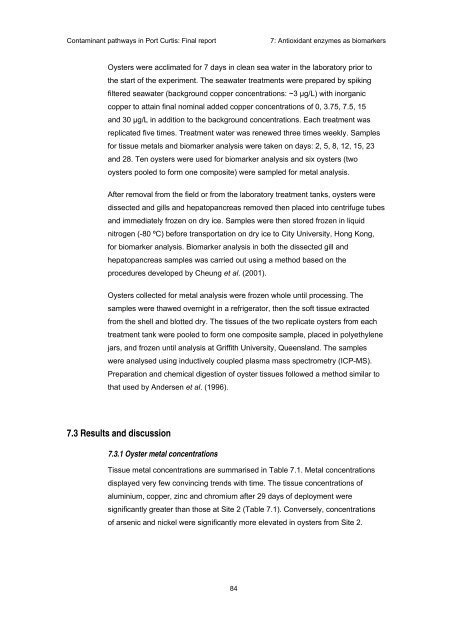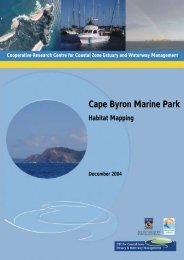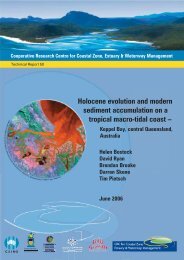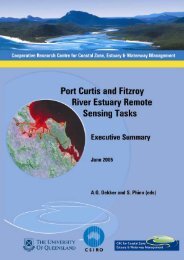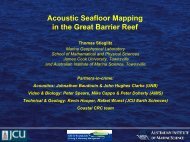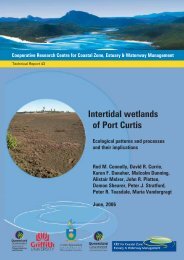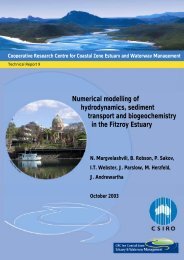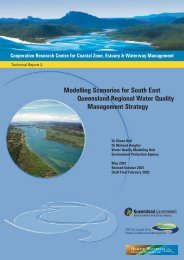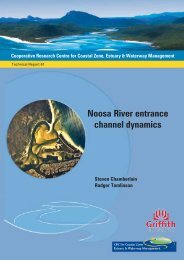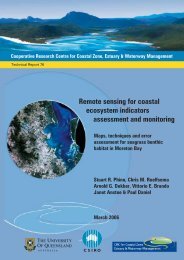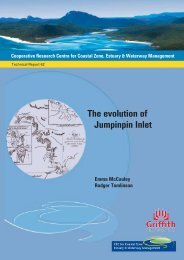Contaminant pathways in Port Curtis: Final report - OzCoasts
Contaminant pathways in Port Curtis: Final report - OzCoasts
Contaminant pathways in Port Curtis: Final report - OzCoasts
Create successful ePaper yourself
Turn your PDF publications into a flip-book with our unique Google optimized e-Paper software.
<strong>Contam<strong>in</strong>ant</strong> <strong>pathways</strong> <strong>in</strong> <strong>Port</strong> <strong>Curtis</strong>: F<strong>in</strong>al <strong>report</strong>7: Antioxidant enzymes as biomarkersOysters were acclimated for 7 days <strong>in</strong> clean sea water <strong>in</strong> the laboratory prior tothe start of the experiment. The seawater treatments were prepared by spik<strong>in</strong>gfiltered seawater (background copper concentrations: ~3 µg/L) with <strong>in</strong>organiccopper to atta<strong>in</strong> f<strong>in</strong>al nom<strong>in</strong>al added copper concentrations of 0, 3.75, 7.5, 15and 30 µg/L <strong>in</strong> addition to the background concentrations. Each treatment wasreplicated five times. Treatment water was renewed three times weekly. Samplesfor tissue metals and biomarker analysis were taken on days: 2, 5, 8, 12, 15, 23and 28. Ten oysters were used for biomarker analysis and six oysters (twooysters pooled to form one composite) were sampled for metal analysis.After removal from the field or from the laboratory treatment tanks, oysters weredissected and gills and hepatopancreas removed then placed <strong>in</strong>to centrifuge tubesand immediately frozen on dry ice. Samples were then stored frozen <strong>in</strong> liquidnitrogen (-80 ºC) before transportation on dry ice to City University, Hong Kong,for biomarker analysis. Biomarker analysis <strong>in</strong> both the dissected gill andhepatopancreas samples was carried out us<strong>in</strong>g a method based on theprocedures developed by Cheung et al. (2001).Oysters collected for metal analysis were frozen whole until process<strong>in</strong>g. Thesamples were thawed overnight <strong>in</strong> a refrigerator, then the soft tissue extractedfrom the shell and blotted dry. The tissues of the two replicate oysters from eachtreatment tank were pooled to form one composite sample, placed <strong>in</strong> polyethylenejars, and frozen until analysis at Griffith University, Queensland. The sampleswere analysed us<strong>in</strong>g <strong>in</strong>ductively coupled plasma mass spectrometry (ICP-MS).Preparation and chemical digestion of oyster tissues followed a method similar tothat used by Andersen et al. (1996).7.3 Results and discussion7.3.1 Oyster metal concentrationsTissue metal concentrations are summarised <strong>in</strong> Table 7.1. Metal concentrationsdisplayed very few conv<strong>in</strong>c<strong>in</strong>g trends with time. The tissue concentrations ofalum<strong>in</strong>ium, copper, z<strong>in</strong>c and chromium after 29 days of deployment weresignificantly greater than those at Site 2 (Table 7.1). Conversely, concentrationsof arsenic and nickel were significantly more elevated <strong>in</strong> oysters from Site 2.84


